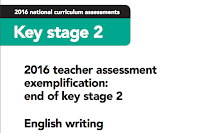Independent Writing - Some Thoughts
So today saw the STA release exemplification materials for 2016 KS1 and KS2 Writing Teacher Assessments. If you haven't yet had a look, click the following pictures -
I think the one thing a lot of teachers will be wondering is what does an independent write look like?
Here is some info from Herts for Learning -
I would love to hear what you think about the publications today, you can vote on this twitter poll-
I think the one thing a lot of teachers will be wondering is what does an independent write look like?
Here is some info from Herts for Learning -
Also, this document shared via @AP_Literacy is also worth a read - IMPORTANT UP-TO-DATE INFORMATION ABOUT KS1 AND KS2 ASSESSMENT/MODERATION FOLLOWING A STANDARDS AND TESTING AGENCY BRIEFING ON 5TH FEBRUARY, 2016
A couple of points that caught my eye -
• The writing that children produce and that moderators will look at should be part of their normal classroom practice. Writing ‘tests’ and ‘cold tasks’ are not the best writing to use to assess writing as children will not produce their best work in these situations. Children working like ‘real writers’ is best practice – children’s writing that is produced at the end of a unit of work may be used as children may be using working walls, success criteria or other scaffolding but they are choosing how to apply the things they have been taught. Discussion of ideas and immersion in vocabulary is all part of good teaching. Directly copying from modelled writing or heavily scaffolded writing would not be considered independent.
• Children CAN use dictionaries when writing independently as this is in the Programmes of Study and is part of normal writing practice. Children still have to make the decision to refer to the resource. However, electronic aids that provide correct spellings are not allowed.
• Children editing and making improvements to their writing are a key part of the National Curriculum. This includes responding to feedback (teacher or peer) as long as the advice is generic and not specific, e.g. ‘have a think about the adjectives you’ve used’ is ok but ‘change that word to something more interesting’ is not ok.
This sounds fair to me, I think what is important in stressing is that modelling writing and shared/guided writing is still incredibly important and should be happening. However, when it comes to an independent write, children should be encouraged to apply what they have learnt from previous sessions and not be given a list of sentences they HAVE to include.
Also, cold tasks can still happen, I find them useful at the start of a unit to see what they children already know, this can then inform planning and help focus on what children need to practise in the build up to their independent writing. Cold tasks or test style writing sessions don't or shouldn't be used as assessed independent pieces.
As far as editing and redrafting, this visual shared by @ICTEvangelist on twitter could be useful -
It links a lot to discussions I have with schools about implementing Alan Peat and Mat Sullivan's Exciting Sentence approach. I love the exciting sentences and it really does improve writing when it is used in the right way. Sometimes, I come across schools and teachers who teach the construction of the sentences but don't teach the 'when to use' and 'why to use' each sentence and so children are filling stories with as many different sentences types without considering the effect they have on the reader. This is something both myself and Alan will be discussing on our upcoming joint conferences.
Alan has written a blog post about the exciting sentence approach and making sure it is used with caution. I recommend reading it to make sure you are not falling into the trap of misusing the sentences - Exciting Sentences - a word of caution
I would love to hear what you think about the publications today, you can vote on this twitter poll-
Reaction to the writing exemplification documents? WT = working towards WB = working beyond— Mr Parkinson (@ICT_MrP) February 8, 2016





Do we know when KS3 is coming out? I've searched the gov.uk. website but resulted in no hits. :(
ReplyDeleteGreat blog ! Totally agree that modelled and shared writing are a crucial part of the writing process and that cold writing does play a part in informing planning.
ReplyDelete